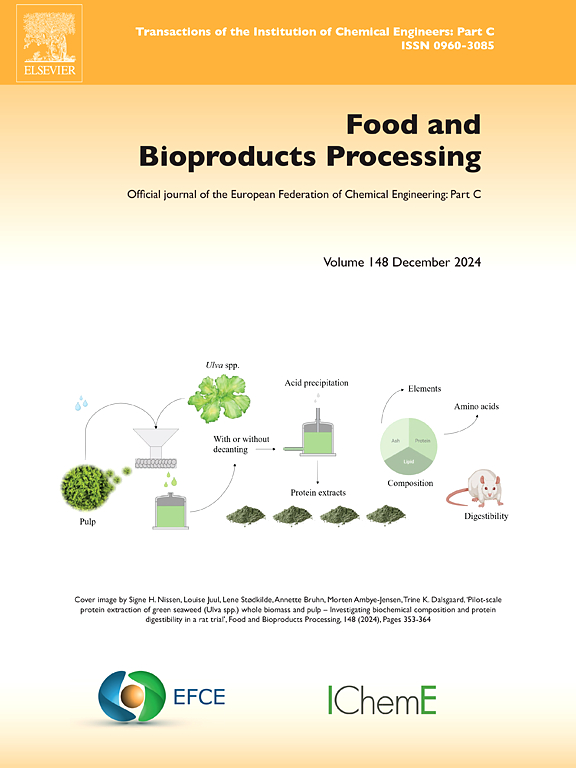Structural reorganization of hydration-limited soft-matter: Mechanistic and sustainability insights for micro-aqueous extraction of fish oil
IF 3.4
2区 农林科学
Q2 BIOTECHNOLOGY & APPLIED MICROBIOLOGY
引用次数: 0
Abstract
Conventional lipid extraction from fish by-products typically relies on high water input and disruption by thermal or hydrolysis to break emulsions and release oil. This study introduces a fundamentally reversed mechanism by micro-aqueous extraction (MAE). This method induces oil release via limited hydration and reassembly of the soft matter without heat or dilution. This MAE approach first dehydrates fish by-products until moisture content reaching ∼18 %, reassembly forming a protein–lipid matrix of high internal phase emulsion gel (φ ∼75 %). Upon controlled micro-aqueous hydration and low-shear agitation, structured proteins aggregate and destabilize oil droplets and release entrapped oil. Compared to heat extraction (HE), MAE achieved higher oil recovery (94.3 % vs. 76.4 %), shortened processing time by 35 %, and decreased oil total oxidation value (TOTOX 1.33 vs. 2.88). Life cycle assessment confirmed lower environmental burden with 62 % reduction in CO₂ emission. The fish meal obtained by MAE retained superior emulsifying activity and structural integrity. Mechanistically, micro-aqueous hydration reduced α-helix content of proteins and decreased oil droplet stability, thereby promoting demulsification. In contrast, drying at 60 °C resulted in lower turbidity and smaller aggregation size of myofibrillar proteins compared to drying at 30 °C, which enhanced their interfacial stabilization. Rheological analysis further revealed that water-limited restructuring of the myofibrillar network played a critical role in controlling viscoelasticity (as reflected by G', G′') and extraction efficiency. This work reveals a counterintuitive pathway for oil recovery, governed by moisture-regulated soft-matter reorganization, which presents a low-energy, high-yield, and sustainable approach for fish by-product valorisation.
水化限制软物质的结构重组:微水萃取鱼油的机理和可持续性见解
传统的从鱼类副产品中提取脂质通常依赖于高的水输入和热或水解的破坏,以打破乳剂和释放油。本研究介绍了一种完全相反的微水萃取(MAE)机理。这种方法通过有限的水化和软物质的重组来诱导油释放,而不需要加热或稀释。这种MAE方法首先使鱼类副产品脱水,直到水分含量达到~ 18 %,重新组装形成高内相乳液凝胶(φ ~ 75 %)的蛋白质-脂质基质。在受控的微水水化和低剪切搅拌下,结构蛋白聚集并破坏油滴的稳定,释放被困的油。与热萃取(HE)相比,MAE获得了更高的油采收率(94.3 %比76.4 %),缩短了处理时间35 %,降低了油的总氧化值(TOTOX 1.33比2.88)。生命周期评价结果显示,二氧化碳排放量减少62% %,环境负担减轻。采用MAE法制备的鱼粉保持了良好的乳化活性和结构完整性。微水水化作用降低了蛋白质α-螺旋含量,降低了油滴稳定性,从而促进破乳。相比之下,与30℃干燥相比,60℃干燥使肌纤维蛋白的浊度更低,聚集尺寸更小,从而增强了其界面稳定性。流变学分析进一步表明,肌原纤维网络的限水重组在控制粘弹性(由G′、G′反映)和提取效率方面发挥了关键作用。这项工作揭示了一种反直觉的石油开采途径,由湿度调节的软物质重组控制,这为鱼类副产品的增值提供了一种低能量、高产能和可持续的方法。
本文章由计算机程序翻译,如有差异,请以英文原文为准。
求助全文
约1分钟内获得全文
求助全文
来源期刊

Food and Bioproducts Processing
工程技术-工程:化工
CiteScore
9.70
自引率
4.30%
发文量
115
审稿时长
24 days
期刊介绍:
Official Journal of the European Federation of Chemical Engineering:
Part C
FBP aims to be the principal international journal for publication of high quality, original papers in the branches of engineering and science dedicated to the safe processing of biological products. It is the only journal to exploit the synergy between biotechnology, bioprocessing and food engineering.
Papers showing how research results can be used in engineering design, and accounts of experimental or theoretical research work bringing new perspectives to established principles, highlighting unsolved problems or indicating directions for future research, are particularly welcome. Contributions that deal with new developments in equipment or processes and that can be given quantitative expression are encouraged. The journal is especially interested in papers that extend the boundaries of food and bioproducts processing.
The journal has a strong emphasis on the interface between engineering and food or bioproducts. Papers that are not likely to be published are those:
• Primarily concerned with food formulation
• That use experimental design techniques to obtain response surfaces but gain little insight from them
• That are empirical and ignore established mechanistic models, e.g., empirical drying curves
• That are primarily concerned about sensory evaluation and colour
• Concern the extraction, encapsulation and/or antioxidant activity of a specific biological material without providing insight that could be applied to a similar but different material,
• Containing only chemical analyses of biological materials.
 求助内容:
求助内容: 应助结果提醒方式:
应助结果提醒方式:


